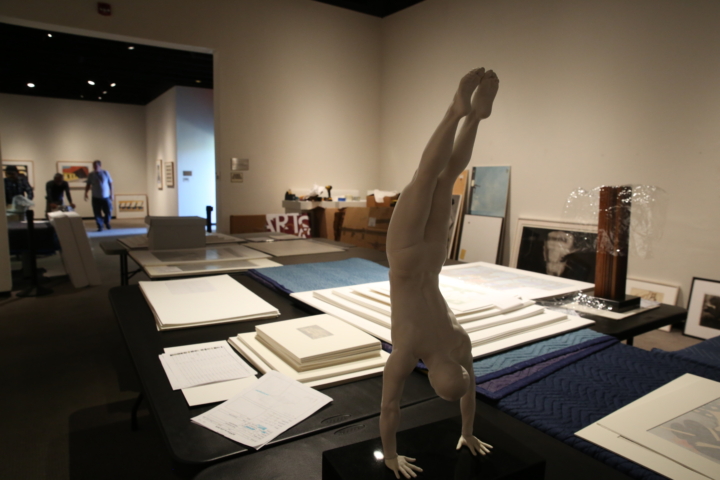A veritable parade of paintings, sculptures, papers and objects is passing through a rigorous process as experts at William & Mary’s Muscarelle Museum of Art document and pack its collection in preparation for storage.
The Muscarelle will temporarily close in early 2023 for expansion and renovation. A ceremonial groundbreaking for The Martha Wren Briggs Center for the Visual Arts will take place Nov. 18.
In the meantime, its collection of almost 7,000 items will be stored off-site in a secure, climate-controlled facility.
“As is typical for a university museum, our collection may be considered encyclopedic,” said Melissa Parris, deputy director of collections, exhibitions and operations. “We have an array of media, time periods and nationalities in our holdings.”

One of the primary motivations for the expansion is to provide adequate space for the growing collection and update the museum’s environmental and storage systems, she added.
“The museum was built in 1983 when the collection numbered less than 1,000 works,” Parris said. “Currently, we have almost 7,000 works, and we have run out of space to safely store objects. We have limited space to work around the art — that is to safely study, house, examine or provide access to scholars.”
Parris and Muscarelle Registrar Laura Fogarty’s ongoing project is taking place in what is usually the museum’s second floor exhibition gallery. It’s become the staging area for numerous steps in a meticulous process of special coordination and handling.
Museum staffers and student interns have worked to process the collection for months. In October, specialists with outside firm Bonsai Fine Arts packaged large and select fragile objects.

Amidst the cataloging and packing, the museum is still processing new acquisitions that are being donated and loans going out to other institutions. A look around snapshots an array of eras, media, styles and views.
“The Muscarelle’s collection of art continues to grow, with important dimensionality being added through the additions of under-represented artists to our holdings,” said Muscarelle Director David Brashear. “But expanding the collection adds complexity to the problem at hand — moving the art offsite to clear the way for the forthcoming renovation and expansion of the museum.”
Each piece has a paper file folder in the many filing cabinets that include copious information on the museum’s holdings. Documentation before packing and storage is key and is done first by checking all of the existing information about a piece of art against its current condition and taking photos.
“While we’re down, we want to ensure that we’re able to support faculty and students by providing images of our collection objects,” Fogarty said. “We may also use reproductions in our offsite gallery space. Additionally, images are important for planning exhibitions and collection galleries in the new museum.”
Pieces are checked for any slipped hinges, loose frames or other areas needing repair and pulled for that work mostly in-house, according to Fogarty. Some undergo a light cleaning and measurement.

“As part of our processing, we are looking at the stability of the works,” Parris said. “If something needs conservation, we’ve prioritized objects for treatment before they are packed and moved. That way, when we re-open, we have works that are exhibition-ready.”
Each piece is packaged and packed according to its shape and special requirements.
For example, special braces and custom enclosures are created for objects with unique needs. Three-dimensional objects, particularly those with appendages and fragile components, may be cavity packed or sunk into a non-abrasive lined foam enclosure, sculpted to their silhouette to prevent shifting in transit. Works on paper are stored in protective, archival Solander boxes.
Works on paper comprise three-quarters of the collection and include photographs, drawings, watercolors, prints and a few collages. Three-dimensional pieces are the smallest component, with paintings numbering more than 500.

Each individual piece will be documented through the series of steps before storage and eventually being unpacked in the new facility.
“Through careful record keeping, we can confirm that we know where an object is at all times and that all the information in our collections management database is correct,” Fogarty said. “That’s been another really important aspect because sometimes legacy data may have incorrect dimensions. Or, new research may yield additional information and that documentation is updated and now associated with the object.”
The art will be ready and waiting for its role in the museum’s next chapter.
“With the collection securely stored offsite at a professional fine arts storage vault, we can safely begin our construction project,” Brashear said.
Jennifer L. Williams, Communications Specialist










